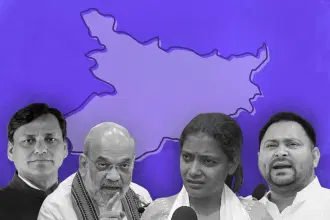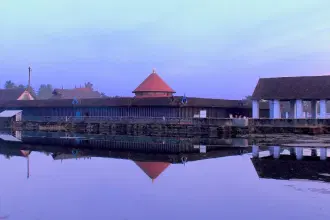Culture
The Forgotten Navaratri: How The Mothers Ruled The Northeast
Nabaarun Barooah
Sep 24, 2025, 12:41 PM | Updated 02:22 PM IST
Save & read from anywhere!
Bookmark stories for easy access on any device or the Swarajya app.
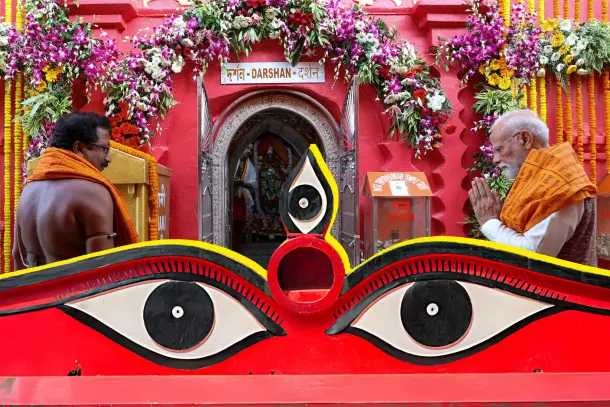

Navaratri is the festival of Shakti, nine nights of remembering the Devi in her many forms, from the gentle Skandamata to the warrior Kalratri. Across the Indian subcontinent, these days are marked by devotion, ritual, and celebration of the eternal feminine.
Yet, if we look eastward towards the hills and valleys of the Northeast, we find a landscape where the Mothers once walked more vividly than anywhere else.
The Northeast is often seen as a frontier defined by churches, missions, English education, and modern conversions. But peel back this recent history and another story emerges. It is one of blood and fertility, of tantra sadhana, of Shakta pithas and goddess cults whose roots go as deep as the soil itself.
It is here, in the heart of Assam, Tripura, Manipur, Meghalaya, Arunachal Pradesh, Mizoram, and Nagaland, that some of the subcontinent’s oldest goddess traditions were born. They were shaped by tribal ritual and Sanskritic tantra alike.
This Navaratri journey moves state by state, tracing the Mothers of the hills, valleys, and rivers: Kamakhya, Kecaikhati, Tripurasundari, Panthoibi, Jayanti, Khuazingnu, and Miawenüo. These goddesses once ruled kingdoms, protected peoples, and demanded sacrifice. They embody a paradox.
Today, the Northeast is often seen as a region dominated by Christianity. Yet it was once the crucible of Shakti, where politics, power, and tantra converged under the gaze of the Mothers.
Assam: The Womb of the Universe
The journey into the Mothers of the Northeast can only begin at Nilachal Hill in Guwahati, where the temple of Kamakhya stands as a cosmic axis around which traditions of tantra across the whole subcontinent revolve.
Climbing up the winding hill road, the city falls away. The sounds of car horns and the ferry whistles on the Brahmaputra give way to the rhythmic clang of temple bells and the chants of pilgrims.
At the summit, the Kamakhya complex reveals itself. It is a cluster of domed shrines with the main temple rising in the middle, crowned with its beehive-like shikhara. Unlike the ornate carvings of northern Indian temples, Kamakhya’s walls are almost austere. Its power is drawn not from sculpted ornamentation but from the depth of ritual and belief it houses.
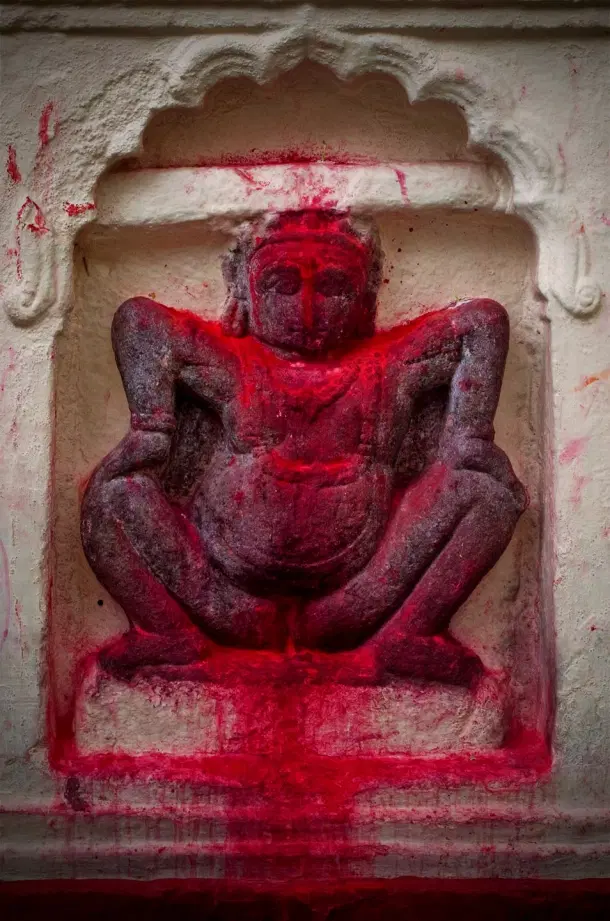
Inside, there is no idol. The sanctum does not present the Devi as warrior or mother in human form. Instead, the yoni of Sati, a cleft in stone constantly bathed in an underground spring, is worshipped. Draped in red cloth, garlanded with flowers, and anointed with vermilion, the sacred cleft is a reminder that here, the goddess is not a distant deity but the very principle of creation, fertility, and regeneration.
Every year in June, during the Ambubachi Mela, the temple closes for three days. The goddess is believed to be menstruating. For pilgrims, this is not a sign of pollution but of sanctity. When the temple doors reopen, the soil and cloth touched by Kamakhya’s menstrual fluid are distributed as prasad, a fertility charm carried home by thousands.
This is a celebration of the female body and its cycles, a theological acknowledgment of what the rest of society often conceals. You can read my detailed piece about Ambubachi Mela here.
But Kamakhya is not alone. Around her, scattered across the hill, are shrines dedicated to the Mahavidyas or the Ten Great Wisdom Goddesses who represent the multiple, paradoxical faces of Shakti.
Their presence here makes Nilachal unique, for no other site in India brings together all ten forms in one sacred geography:
- Kali: the dark, time-devouring mother, naked and terrifying, dancing on corpses, garlanded by skulls, presiding over the planet Saturn.
- Tara: the saviouress, close to Buddhist traditions, a goddess who guides across the ocean of existence, the symbol of knowledge, presiding over the planet Jupiter.
- Tripurasundari: the sixteen-year-old goddess, radiant with beauty, symbol of perfection and cosmic harmony, presiding over the planet Mercury.
- Bhuvaneshwari: queen of the worlds, sovereign of the cosmos, the epitome of beauty, presiding over the planet Venus.
- Bhairavi: fierce and bloodthirsty, mistress of death and dissolution, who presides over the Lagna (Ascendent) House.
- Chhinnamasta: self-decapitated, drinking her own blood, an image of sacrifice and transcendence, the ultimate symbol of destruction, presiding over the planet Rahu.
- Dhumavati: the smoky widow, embodiment of inauspiciousness, teaching detachment and renunciation, presiding over the planet Ketu.
- Bagalamukhi: she who paralyses enemies, goddess of stambhana (stilling power), presiding over the planet Mars.
- Matangi: goddess of knowledge, patroness of music, art, and speech, presiding over the Sun.
- Kamala (Lakshmi): the lotus-born, bestower of prosperity and abundance, the goddess of the inner mind, presiding over the Moon.
Together, these ten do not form a simple pantheon but a mandala, each representing aspects of Shakti that range from nurturing to terrifying, auspicious to inauspicious, worldly to transcendental. The seeker who circles their shrines undertakes not just a pilgrimage but a psychological journey through the spectrum of divine femininity.
Politically, Kamakhya was no mere temple but the legitimising force of kingdoms. The Stambhas, Koch kings, the Ahoms, and later the British, all understood the shrine’s importance. To control Kamakhya was to control Assam’s spiritual heart.
Even today, the Ambubachi Mela is the largest gathering in the Northeast, a reminder that beyond electoral maps and census figures, the pulse of Shakti beats strongest here.
But Kamakhya and the Dasa Mahavidyas are not the only mothers in Assam.
In Old Gauhati, Ugratara, a fierce aspect of Devi, is worshipped with blood offerings. Among the Bodos, the goddess Mahamaya is revered, less as an abstract tantric deity and more as a protective mother of the tribe.
In Barak Valley, Maa Kachakanti testifies to the fusion of tribal ferocity and tantric ritual.
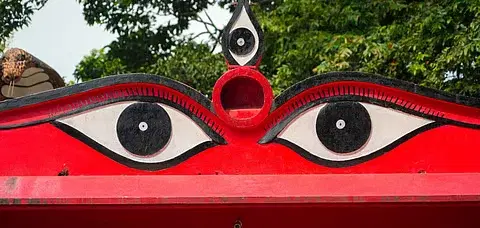
Arunachal Pradesh – The 'Flesh-Eater'
If Kamakhya embodies the creative womb of Shakti, then Kecaikhati represents her untamed hunger. The very name, “the eater of raw flesh,” evokes both awe and dread, pointing to a deity who exists outside the boundaries of standard gentility.
The principal shrine, known as Kecaikhati Than, lies in Malinithan, on the borders of Arunachal Pradesh, historically connected with the Chutia kingdom.
Unlike the grand temple complexes of Guwahati, this is a modest grove-bound site, its stone structures half-consumed by roots and moss, as if nature itself insists on reclaiming her. Entering the precincts, one senses a different energy: austere, feral, less about ornament and more about power.
Here, the Deoris, a priestly community distinct from mainstream authorities, preside over the rituals.
Their oral traditions recall a time when human sacrifices were offered to the goddess well into the medieval period. Even after these were outlawed, animal offerings such as goats, pigs and fowls have continued without interruption.
To this day, when a community faces crisis such as famine, disease or conflict, Kecaikhati is invoked, her altar stained with the blood of sacrifice.
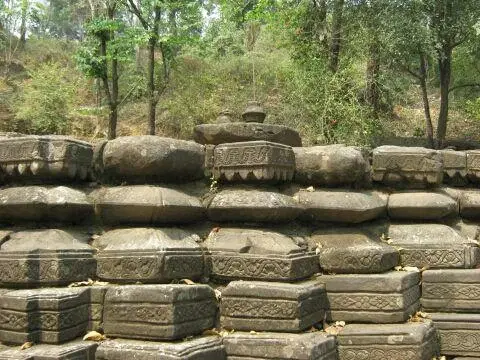
The symbolism is clear. She is both destroyer and protector. By devouring life, she ensures regeneration. By accepting blood, she restores balance. In her, the violent and the nurturing are not contradictions but complements, a worldview that runs through much of Northeastern Shakta worship.
Kecaikhati’s influence was not confined to Arunachal alone. Her cult radiated outward, shaping other goddess traditions across Assam and into the Barak Valley.
The most prominent example is Kachakanti of Udharbond, revered as the kula devi of the Kachari kingdom, which fuses the energies of Durga and Kali, standing as a tutelary goddess of both polity and people.
At the Kachakanti Temple, her worship retains echoes of Kecaikhati’s ferocity but is framed within a more localised, royal idiom. In the days of the Kachari kings, no military expedition or state festival was complete without offerings to her. Even today, rituals blend blood sacrifice with agrarian fertility rites, affirming the goddess as guardian of both war and harvest.
Together, Kecaikhati and Kachakanti illustrate a deeper pattern of the Northeast’s Mothers. They are not distant goddesses of mythology alone but active forces shaping kingdoms, legitimising dynasties and binding communities in covenant.
To stand before their altars is to stand before a power at once intimate and terrifying, Shakti in her rawest form.
Meghalaya – The Tribal Durga
Leaving the floodplains of Assam, the road rises into the mist-cloaked Nartiang in the Jaintia Hills of Meghalaya, the summer capital of the Jaintia kings. Here, amid rolling green ridges and sacred groves, stands the Jayanti Devi Temple, a Shakti Peetha where Sati’s left thigh is believed to have fallen.
Inside the sanctum are two ancient ashta-dhatu idols of Durga in her most ferocious form: ten arms raised, a lion beneath her, and a trident poised to strike Mahishasura. You can read my piece about the temple in detail here.
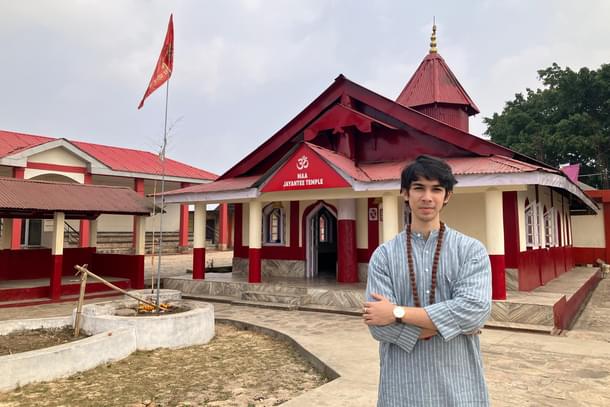
The history of Jayanti is inseparable from the Jaintia kingdom. Matrilineal in inheritance but martial in spirit, the kingdom embraced Tantric Hinduism under its Brahmin rulers while also weaving in the animist rituals of the Pnar people.
Sacrifice lay at the heart of Jayanti’s cult. Goats, buffaloes, and in older times humans were offered to her, especially on the night of Durga Ashtami.
Colonial records speak of victims’ heads rolling into a pit that led straight into the Myntang River below, a chilling reminder of the blood that once sealed the bond between goddess and kingdom.
Priestly service at Nartiang carries its own unique story. When no Brahmin would perform the rituals involving narabali, the Jaintia kings invited priests from far away Maharashtra. A Chandraseniya Kayastha Prabhu family, bearing the surname Deshmukh, accepted the charge.
Since then, across thirty unbroken generations, the Deshmukhs have served as Doloi, the chief priests of Jayanti, blending their Maharashtrian inheritance with the raw Shakti of the Khasi hills. Even today, the present Doloi, Anil Deshmukh, oversees the great rites of Durga Puja here.
Though human sacrifice was abolished after the British annexed the Jaintia kingdom in 1835, the ritual memory remains alive. On the midnight of Ashtami, a goat is dressed in human clothes such as dhoti, turban, earrings, and a mask of human visage, and sacrificed with a straight-edged sword, echoing the ancient narabali.
The symbolism is unmistakable. The kingdom may be gone, but the power of the goddess endures.
Durga Puja here has its own local flavour. The goddess is invoked not in clay, but through a banana plant clothed and adorned as the Mother. On the final day, the plant, infused with the spirit of Devi, is carried in procession to the Myntdu River and immersed, returning the goddess to her celestial abode.
As the community gathers by the banks, one feels the continuity of a tradition where the Mother is fierce and fertile, demanding sacrifice yet offering protection.
Tripura – The Queen of Udaipur
In the old capital of Udaipur, nestled by the Rudrasagar Lake, rises the Tripurasundari Temple, one of the fifty-one Shakti Peethas and the most luminous jewel in Tripura’s sacred landscape. Local lore holds that Sati’s right foot fell here, sanctifying the ground and binding it forever to the worship of the Divine Mother.
The temple, built in 1501 by Maharaja Dhanya Manikya, stands on a small hillock, its ochre walls and domed shikhara glowing against the green of the valley below.

Inside the sanctum rests the idol of the goddess, carved from black stone, radiating an aura of regal authority. To gaze upon her is to feel both protected and subdued, as if the Mother is simultaneously offering refuge and demanding surrender.
For centuries, Tripurasundari has been more than a goddess. She has been the kula devi of the Manikya dynasty. Every royal expedition, every coronation, every crisis was ritually bound to her will.
Sacrifices were central to her cult. Goats, buffaloes, and in earlier centuries even larger offerings were brought to her altar. The bali-sthan, or sacrificial pit, still stands in the courtyard, mute witness to a time when the kingdom’s fate was tied to the flow of blood at the goddess’s feet.
The priests of Tripurasundari follow a unique tradition. Drawn originally from Bengal, they conduct daily puja in the classical Shakta manner such as reciting the Chandi, offering flowers, incense and lamps.
Yet alongside these rites, traces of older Tantric practices remain, such as the offerings of meat and blood during certain festivals, the nocturnal rituals whispered in secrecy, and the presence of yoginis and sadhakas who once gathered here to perform sadhana under royal patronage.
Durga Puja at Udaipur is unlike anywhere else. The temple draws thousands, who climb the hillock with baskets of offerings, their chants of “Jai Maa Tripura Sundari” mingling with the beating of drums.
On Ashtami, the sacrifice of buffaloes is still performed, the sword flashing in the torchlight, recalling the ancient pact between goddess and king. As the blood flows into the earth, the crowd erupts in devotion, believing that the Mother, appeased, will guard the land for another year.
Manipur – The Warrior Mother
In the verdant valleys and rolling hills of Manipur, Panthoibi reigns as the supreme goddess of the Meitei people. Often described as the Durga of Chandi, she embodies a paradoxical power: both lover and warrior, nurturer and protector.
Her mythology is interwoven with the very identity of Manipur. She is the guardian of the land, the custodian of its culture, and the inspirer of its martial and artistic traditions.
Panthoibi’s tales are told in ritual dances, songs and oral narratives. The Panthoibi Jagoi, performed in temples and courtyards during the festival of Lai Haraoba, evokes her courage in battle, her cunning in outwitting enemies, and her tenderness in the sphere of love.
It is a duet dance form, portraying the romantic love affairs between Nongpok Ningthou, the supreme deity, and Panthoibi.
In every gesture, she asserts the strength and identity of the Manipuri people, even as they faced waves of Vaishnavisation from the 18th century onward and later pressures of Christianisation.
Temples dedicated to Panthoibi, though modest in size, are suffused with energy. Images and sculptures depict her in warrior stance seated on a tiger or a white horse. She is venerated not only as a goddess of war but also as a cultural emblem, her stories preserving Meitei heritage and sustaining community cohesion.
Even in modern times, Panthoibi survives as a syncretic figure, her worship adapting to changing religious landscapes while remaining unmistakably Meitei. She continues to inspire devotion, martial spirit and a sense of belonging, reminding the people of Manipur that their history, identity and culture are inseparable from the Goddess who watches over them.
Mizoram – The Guardian of Crops
In the mist-covered hills of Mizoram, Khuazingnu stands as the protective Mother of the land. Revered by the Mizo people, she is a guardian goddess, overseeing villages, forests and the fragile balance between humanity and nature.
Khuazingnu embodies vigilance and care, ensuring the prosperity and safety of her devotees, especially in a region historically shaped by tribal autonomy and close-knit village communities.
Her worship is expressed through seasonal festivals of harvest and sowing, offerings and oral narratives that recount her interventions in times of famine, conflict or misfortune.
While Christianity has reshaped much of Mizoram’s religious landscape, Khuazingnu’s presence endures in folk songs, proverbs and village rituals, often blending ancestral animism with protective Hindu or Shakta motifs. She is a reminder of the land’s sacredness and the enduring bond between the people and the hills they inhabit.
Nagaland – The Mountain Mother
Among the Nagas, especially the Angami tribe, Miawenüo is remembered as the fierce guardian of life, community and identity. Though less widely known beyond the state, she occupies a central place in oral histories and ritual observances, embodying both martial prowess and maternal protection.
Legends depict her intervening in times of tribal conflict, guiding warriors and safeguarding villages from external threats.
Her worship incorporates local forms of devotion, often through seasonal feasts, dances and offerings that blend pre-Hindu animist practices with the concept of Shakti as a protective cosmic force.
Despite the influence of Christianity today, Miawenüo’s stories and symbolic presence persist in Nagaland’s cultural memory. She remains a testimony to the resilience of indigenous goddess traditions and the ways in which divine feminine power shapes social identity and collective consciousness.
The Forgotten Navaratri
Beneath this veneer of churches and mission schools, the earth still remembers its Mothers.
The rivers, hills and forests hold stories older than the churches. The soil itself carries the memory of Tantric sadhanas, blood-soaked altars and fervent devotion.
In some communities, even those that have embraced Christianity retain faint but unmistakable traces of goddess motifs, now folded into new rituals and hymns, yet echoing the older patterns of reverence.
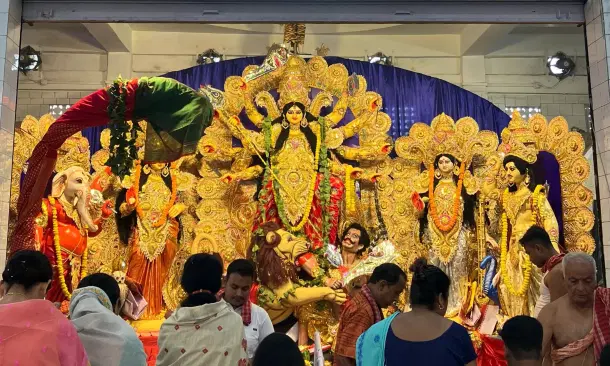
To honour the Mothers of the Northeast during Navaratri is to acknowledge a truth often overlooked. Shakti is not bound by geography, by state borders or by the religious labels that history may impose.
The womb of Kamakhya, where life and cosmic energy converge, the fierce altars of Kecaikhati, where protection was sought through sacrifice, the chanting of the Mahavidyas across hidden shrines are as intrinsic to India’s goddess traditions as Bengal’s Durga Puja, Tamil Nadu’s Meenakshi temple, Katra’s Vaishno Devi shrine or Mysore’s Chamundeshwari temple.
They are not peripheral. They are the living edge of a pan-Indian devotional imagination; raw, primal and enduring.
Even in regions where church towers now dominate the skyline, the Mothers persist, silent, unseen, yet unextinguished. They are woven into the soil, the rivers, the monsoon clouds, the stones of the hills and the stories whispered from one generation to the next.
They endure not as relics but as living presences, reminding us that Shakti is never fully erased, never fully forgotten.
This Navaratri, invoking them is to remember that the festival is more than ritual or spectacle. It is a call to witness the resilience of life itself, to honour sovereignty and survival, to feel the rhythms of existence in their fullest intensity.
In celebrating them, we do more than mark days on a calendar. We remember that victory over demons, external or internal, is only one dimension of Shakti.
The deeper lesson is of endurance of the Divine Feminine across time and space. Across the valleys, the rivers and the hilltops of the Northeast, these Mothers remain, waiting to be remembered, honoured and invoked.

